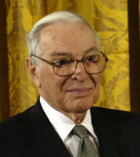 |
| |
Arrow's Impossibility Theorem:
Is There a Best Procedure? Arrow’s Impossibility Theorem
Because plurality rule, the Borda count, singular transferable vote, instant
runoff, and approval voting all reduce to majority rule for two candidates
and an odd number of voters, there needs to be some other way to evaluate and
compare election procedures. Kennth Arrow’s Impossibility Theorem was born out of this idea. Can
one determine an election procedure to satisfy a collection of reasonable properties? And,
what are the properties? In Arrow’s language, the properties are
called “axioms.” A description of these axioms are preceded by a brief historical
sketch.

Kenneth Arrow
Kenneth Arrow’s Impossibility Theorem was part of his doctoral research
in economics at Columbia University where he earned his doctrate in 1951; his research was published the same year as the book, Social Choice and Individual
Values. Because of his work in social choice/voting theory, as well as his work
in economics on the general equilibrium theory he received the
Nobel Prize in Economics in 1972, sharing the prize with John Hicks. At
51, Arrow was the youngest person ever to receive the Prize. Not only
has the implication of Arrow’s Impossibility Theorem had great impact
on voting theory, but Arrow’s axiomatic approach has had great impact,
too. Here is one formulation of Arrow’s axioms:
- Universality: Each individual voter ranks the n candidates from 1 to n. The candidate ranked i is preferred to all candidates ranked j where j > i. There are no restrictions on which rankings are allowed.
- Transitive Outcomes: The societal outcome of an election procedure is a ranking possibly with ties of the candidates. If the society prefers candidate A to candidate B and prefers candidate B to candidate C, then A is ranked above B and B is ranked above C. Because A is ranked above C, then the society prefers A to C, too.
- Unanimity: If all voters prefer candidate A to candidate B, then the societal ranking should place A above B.
- Independence of Irrelevant Alternatives: The societal ranking
of a pair of candidates A and B should only depend on how the voters
rank the two candidates. To rank these two candidates, it is
irrelevant to factor in how the voters rank other candidates. More
specifically, suppose that the society ranks A above B and C. If
some voters decide to change their ranking of B and C, then it should
not affect the societal ranking of A and B: A should still be
ranked above B.
|
Anecdotal Interpretation of Independence of
Irrelevant Alternatives
Consider the shopper that tries on a pair of shoes. The clerk indicates that the shoes are available in brown and black. The customer decides to get the shoes in black. The clerk finds a pair of the shoes in mahogany and lets the customer know. Armed with new information, the customer decides to get the shoes in brown instead! Despite having chosen black over brown when mahogany was not available, the option of having the shoes in mahogany (a supposedly irrelevant alternative) caused the shopper to switch to brown (thereby affecting the decision). The shopper’s
decision making fails to adhere to the Independence of Irrelevant Alternatives
axiom.
|
Taken individually, Arrow’s axioms appear to place reasonable
requirements upon an election procedure, especially when the possible
affect of the independence of irrelevant alternatives is highlighted in the
boxed anecdotal description (see above). To Arrow’s surprise, the only election
procedure that satisfies the above axioms isn’t much of an election
procedure at all!
Arrow’s Impossibility Theorem For three or more
candidates, the only procedure that satisfies the above four axioms is a dictatorship,
in which the outcome of an election always agrees with a specified voter’s
preferences. That voter is referred to as the “dictator.”
The language of Arrow’s theorem can be misunderstood. It does not
mean that democracy is doomed to failure and that only dictators are sound
political institutions. Arrow’s theorem states that there is no
procedure to decide among three or more candidates that satisfies the above properties. If
the axioms are an ideal that cannot be met, then other, less stringent, criteria
should be used to compare and evaluate election procedures. Or, as may
be the case, the selection of an election procedure is a decision about which
of the above axioms is less important to the application at hand.
Don Saari of the University of California, Irvine, provides
a movie, “What
Causes Voting Paradoxes,” that describes the misinterpretation of
Arrow’s theorem at his website.
Understanding Arrow’s Impossibility Theorem
Hodge and Klima (p.79, Mathematics of Voting and Elections: A Hands-On Approach) include the following number-theoretic example to develop intuition about Arrow’s theorem. They ask the following question:
- Is it possible for a positive integer to be divisible by 2, 11, and 23 and to be less than 500?
Notice how each of the characteristics (from the end of the list
to the front) reduces the set of possible positive integers. The
set of all positive integers less than 500 consists of 499 integers,
S1 = {1, 2, 3, … , 499}. The 21 integers in S1 that are
multiples of 23 form the set S2:
{23, 46, 69, 92, 115, 138, 161, 184, 207, 230, 253, 276, 299, 322,
345, 368, 391, 414, 437, 460, 483}.
Let S3 be the set of integers in
S2 that are evenly divisible by 11. Then, S3 = {253}. Because
there are no even integers in S3, there is no positive integer less
than 500 that is evenly divisible by 2, 11, and 23.
Arrow’s theorem is referred to as Arrow’s Impossibility Theorem because the inclusion of a fifth axiom (No Dictatorship) ensures that there is no procedure that satisfies all five axioms. Hence, it is impossible for a procedure to satisfy all five axioms. As such, Arrow’s
theorem is in the spirit of the above example.
|
.
.
|
|
 |
|
 |



